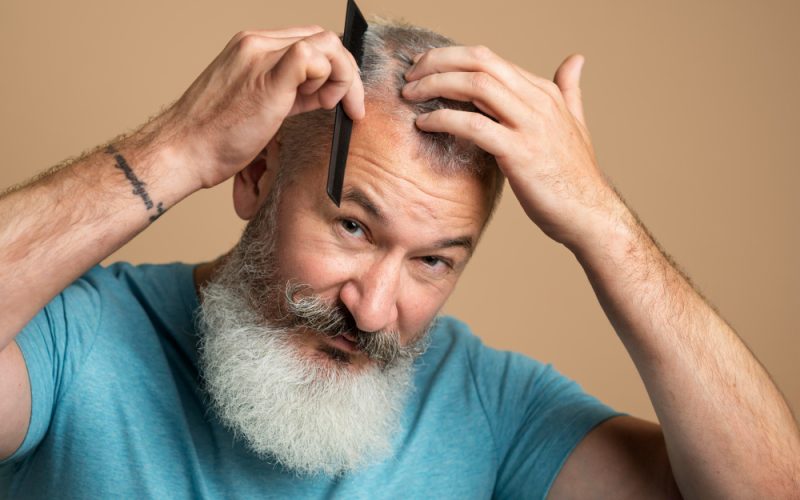Introduction
Hair loss hurts. You might run your fingers through your hair and worry about what you see. Well, androgenetic alopecia, also called pattern hair loss, can feel permanent. You might wonder if reversing it is possible. In this blog, we’ll explore what science says, look at proven treatments, check out lifestyle steps, and look at cutting-edge research. Plus, we’ll touch on clinical trials for androgenetic alopecia to show what comes next.
What Is Androgenetic Alopecia and Why Does It Happen?
Androgenetic alopecia causes hair thinning in specific areas. Men often lose hair at the temples and crown. Women may notice a widening center part.
Key causes include:
- DHT hormone: Affects follicles and shrinks over time.
- Genetics: Family patterns often reveal the risks.
- Hormonal shifts: Especially during aging or stress.
Moreover, male and female patterns differ in how and where hair thins. Understanding the cause helps you choose sensible steps.
Check More: What to Expect in a Neuropsych Evaluation in Colorado Springs
Can You Actually Reverse It? What Science Suggests
Well, reversing doesn’t mean full hair restoration overnight. Instead, science points to two main benefits:
- Slowing down further hair loss.
- Stimulating some regrowth in thinning zones.
Moreover, early action gives you better results. If you catch it early, studies show you keep more hair. However, the results still vary. Some see thick regrowth; others just notice less shedding.
Therefore, realistic hope is smart hope. Let’s explore treatments backed by science.
What Treatments Actually Work?
1. Medications: Minoxidil and Finasteride
Doctors often recommend these first.
- Minoxidil: Applied twice daily, it boosts blood flow and may trigger follicle activity.
- Finasteride (for men): Taken as a pill, it lowers DHT levels to slow follicle damage.
- Study results: Minoxidil regrows hair in up to 60% of users. Finasteride helps about half of men slow loss.
Moreover, combining both often gives better results. However, finasteride doesn’t suit women. You need to check with a professional.
2. Low-Level Laser Therapy (LLLT)
This treatment uses a gentle red light.
- It comes as combs, caps, or helmets.
- It improves blood flow and stimulates follicles.
Moreover, small trials show more hair growth after months of use. However, results take time and devices can cost hundreds. But it’s a safe at-home option.
3. Platelet-Rich Plasma (PRP) Therapy
In this procedure, you:
- Donate a small blood sample
- Clinicians spin it to concentrate growth factors
- They inject plasma into your scalp
Research shows it can:
- Reduce shedding
- Increase thickness
- Help regrow new hair in some
Moreover, you need several sessions, and it costs more than other options. Yet some people see good results.
Are Natural Remedies Worth Trying?
You might prefer gentle, plant-based options. Some popular choices include:
- Rosemary oil: A few studies suggest it might match minoxidil in boosting scalp health.
- Pumpkin seed oil: May support testosterone balance when taken as a supplement.
- Scalp massage: Just five minutes daily can increase blood flow.
Moreover, these methods carry a low risk. However, evidence remains limited. So, use them as support, not your main path. Blend them with proven treatments.
How Lifestyle and Diet Influence Hair Loss
Often, we overlook how everyday habits shape hair health. Let’s break it down.
1. Stress control
- Stress triggers cortisol levels.
- Cortisol can worsen hair shedding.
2. Nutrition matters
- Your body needs iron, zinc, and protein to support your follicle health.
- Lack of these can speed up thinning.
3. Sleep and exercise
- Good sleep balances hormones.
- Exercise boosts circulation which helps your scalp.
Moreover, try these steps daily:
- Reduce stress by breathing or walking.
- Eat beans, eggs, spinach, fish, and nuts.
- Keep a sleep schedule.
- Move often, walk, stretch, or bike every day.
These habits support treatments and make them work better.
What About Hair Transplants? A More Permanent Fix?
Surgery offers a more lasting solution. A surgeon moves healthy follicles to thinning spots.
Here’s what to know:
- It works best when Donor areas have healthy hair.
- Recovery takes weeks but results last long term.
- Costs vary from a few thousand dollars upward.
- Doctors sometimes recommend it when medicines don’t help enough.
Moreover, people see noticeable growth after months. That said, it suits those ready for a surgical step. Most try topicals or lasers first. Now, what does the research pipeline look like?
Where Research Is Headed
Researchers are exploring new pathways:
- Stem cell therapy aims to revive inactive follicles.
- Gene editing might turn off DHT sensitivity in follicles.
- New molecules now enter clinical trials to test safety and effectiveness.
Moreover, many studies run now may bring new tools soon. Therefore, ask a dermatologist if a trial fits your story.
Conclusion
Reversing pattern hair loss takes steady work and patience. You won’t wake up with a full head of hair by morning. However, science shows that early, consistent steps can slow hair loss and recover some scalp coverage. Proven tools like minoxidil, finasteride, lasers, or PRP each help. Support them with better habits, like balanced meals, stress care, and sleep. Even adding natural remedies can boost results. Meanwhile, research makes new options possible. You might also explore addressing alopecia barbae if facial hair loss worries you. Your next step? Talk to a dermatologist or see if you qualify for a trial. Your journey may feel slow, but every move forward counts. Amelia Murphy












